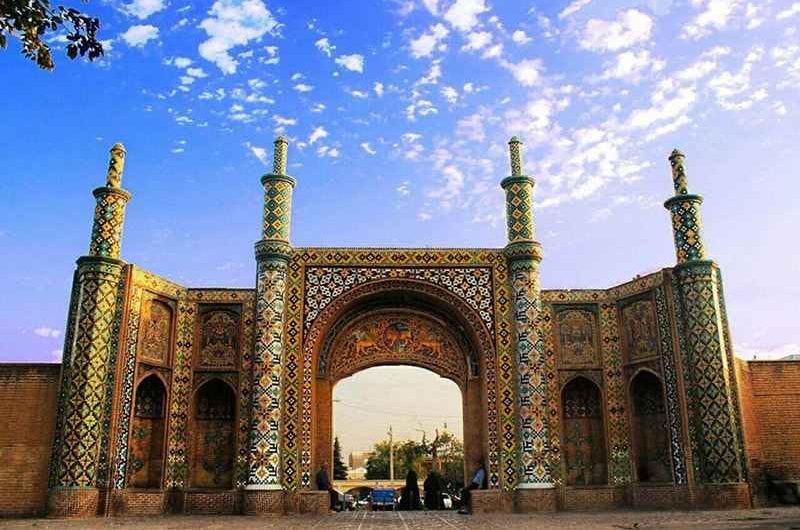Qazvin
During the Persian Empire, a 3000-kilometer highway was built called the Persian Royal Road by order of Darius I that connected various satrapies from present-day Iran to the Mediterranean Sea, passing through present-day Turkey. The Persian Royal Road was part of the greater trade route known as the Silk Road that stretched from the city of Ecbatana in Hamedan to the Aegean Sea of Smyrna in Turkey.
Qazvin has its roots in the heyday of trade on the Silk Road in Iran. However, with the transfer of the capital of the Safavids from Tabriz to this city, it also became a political and commercial center. In the early years of the Islamic era, Qazvin served as a base for Arab forces. Destroyed by Genghis Khan (13th century), the Safavid monarchs made Qazvin the capital in 1548 and after half a century, they moved it to Isfahan in 1598. During the Qajar dynasty and then the contemporary period, Qazvin has always been one of the most important government centers due to its proximity to Tehran.
Sightseeing places of Qazvin
Qazvin Bazaar
The Sa’d al-Saltaneh caravanserai, with its peculiar architecture, is one of the most spectacular places in the traditional Qazvin bazaar. This brick caravanserai contains several entrance gates, some of which are connected to the surrounding streets or other parts of the Bazaar. Entrance doors open into a lobby with a beautiful architectural style. There is a Chahar-Sough on the south side, with a dome on top. Around this cross-shaped passageway are 16 rooms with a height of 1 meter and carved wooden doors.
Ersie Optic Cafe
During the walk along the corridor of the caravanserai, there are many tea houses, or rather cafes, that invite visitors to discover the wonders inherited from antiquity. Among these tea houses, which were once merchants’ shops, is one called Ersie. This former teahouse from the Qajar period offers a beautiful space to sample typical Qazvin drinks and sweets. The interior of the house is similar to a museum, as the owner has kept many objects from the past.
Shahzadeh Hossein Mausoleum
A religious complex that includes a mosque and the mausoleum of the son of the eighth imam of the Shiites, who is buried in Mashhad. The mausoleum is reminiscent of a palace complex with a walled garden, rows of plants, small porticoes (iwans), niches, tombstones, and beautiful tile ornaments. The facade of the main gate consists of six crowned ornamental minarets. The tomb is covered by a dome of blue and yellow tiles. The central part of the building is decorated with numerous mirrored mosaics and the interior is decorated with mirrors, crystals and chandeliers, typical elements of the sanctuaries.
Chehel sotun
This pavilion from the Safavid era was originally part of the first palace of the Safavid dynasty in 1596. The decorations made in the Safavid and Kayar periods are well distinguishable: the tiles on the outside are from the Kayar period, and the wall paintings on the inside from the Safavid period. In the development of architecture, the Chehel Sotun palace in Qazvin anticipates a particular style during the reign of the Safavids as well as in other cities in Iran such as Isfahan and Zanyan.
Hammam Qajar
One of the oldest and largest baths in Qazvin built in 1679 by Emir Goneh Khan Qazvini. Originally, the bath belonged to the Shah Abbas commanders and was called “the Shahin’s bath.” There are separate facilities for men and women. The bathroom portal faces south and ends with a spiral staircase.
Cantor Church
The smallest church in Iran and the third smallest in the world, it is one of the least known attractions in Qazvin. This church is also known under the name of “Russian Church”, a symbol of Orthodoxy.
Sardar Bozorg water reservoir
This ancient water reservoir is one of the famous monuments of Qazvin, built in 1812. Two brothers named Mohammad Hassan Khan and Mohammad Hossein Khan, commanders from the time of Fath Ali Shah, built this building with unique characteristics.
Qazvin Museum
A place where it has a precious treasure of various historical objects exhibited in different sectors. One of these objects is a statue representing the bust of a Sumerian in marble. A series of ceramics and plates of different shapes and styles are the other wonders of the museum. Strolling through the most famous square in Qazvin, “Sabzeh Meydan”, the museum building stands out for its fantastic construction, as it was the former administrative headquarters of the Safavids when Qazvin was the capital.
Alamut Valley
Some of the most mysterious tourist attractions in Iran are found in the Alamut and Shahrud valleys. The magnificent slopes of Alborz have spectacular inspirations that embody the beautiful landscapes of Switzerland, Patagonia, the central regions of Australia and the high plateaus of Syria. Alamut Castle is located at the western end of the Alborz Mountains, between the Qazvin Plain in the south and the Mazandaran province on the Caspian Sea in the north. In the past, part of these mountains formed the Deylan district, where it remains wild and remote. This area, located between the central plateau of Iran and the Caspian Sea, constitutes a formidable natural barrier. On the north side, the slopes are thickly forested and there are wild animals like wild boar, bear and even some species like the Caspian tiger, which is on the brink of extinction.



Comments